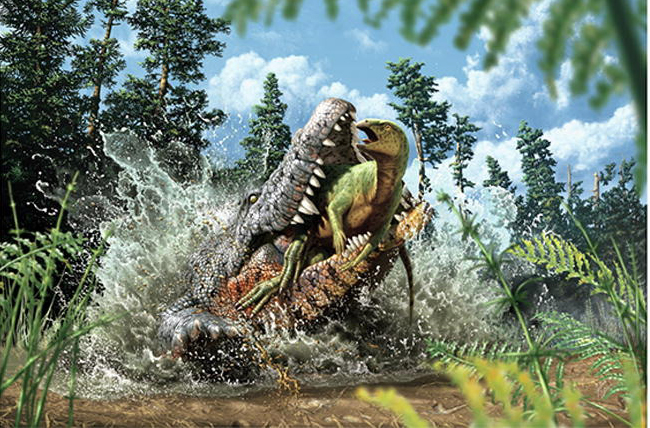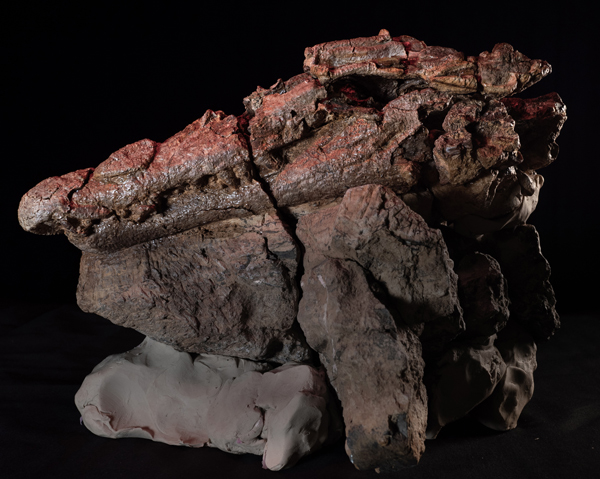Scientists have announced the discovery of a new genus of crocodyliform from the Late Cretaceous Winton Formation of Queensland, Australia. Named Confractosuchus sauroktonos it is only the second crocodyliform known from the Cenomanian-aged Winton Formation and remarkably, the last meal of this predator has been preserved. The abdominal contents consist of the partial remains of a juvenile ornithopod, thus providing the first evidence of crocodile/dinosaur predation in Australia.
Furthermore, the ornithopod bones represent the first skeletal remains of this group reported from the Winton Formation, previously only known from tracks and shed teeth, the unfortunate dinosaur that was eaten by Confractosuchus may represent a new taxon.

A life reconstruction of Confractosuchus sauroktonos capturing the juvenile ornithopod. Picture credit: Dr Matt White/Australian Age of Dinosaurs Museum.
Picture credit: Dr Matt White/Australian Age of Dinosaurs Museum
“Prehistoric Croc” High Resolution Scans Reveal Delicate Fossil Bones
The crocodile specimen consisting of a nearly complete skull with post-cranial material representing about 35% of the total skeleton was discovered in 2010, on the Elderslie Station near to the town of Winton (Queensland). A field team was excavating the remains of a titanosaur and during the removal of the overburden the crocodile fossil material was found. Unfortunately, the concretion containing the fossil was partly crushed by an excavator. The small bones contained within the concretion were too fragile to be removed from the hard stone surrounding them so the object was subjected to neutron and synchrotron X-ray micro-computerised tomography so their details could be revealed.

The skull of the newly desribed Confractosuchus sauroktonos, only the second crocodyliform to be described from Winton Formation fossils. Picture credit: Australian Age of Dinosaurs Museum.
Picture credit: Australian Age of Dinosaurs Museum
“Broken Lizard Killer”
The diet of fossil crocodyliforms are usually inferred based on distinctive bite marks on fossil bone, although it has long been suspected that just like their extant relatives, ancient crocodiles would have preyed upon a wide variety of other animals. This fossil specimen indicates that young dinosaurs were on the menu for Confractosuchus.
The genus name of the new taxon is derived from Confractus which means “broken” in Latin, a reference to the shattered concretion in which the fossil material was preserved and suchus from the Greek for the Egyptian crocodile god Sobek. The species name is also from the Greek meaning “lizard”, a common word used as a suffix for the Dinosauria and ktonos meaning “killer”.
Although the tail and hind legs were missing, the researchers estimate that this Confractosuchus preshistoric croc individual was around 2.5 metres long, but it was not fully grown. Analysis of the teeth and jaws suggest that it probably had a similar diet to an extant caiman, it probably did not specialise in hunting and killing young dinosaurs, but it would not have turned down the opportunity of catching a young dinosaur or scavenging a corpse.
Analysis of the ornithopod fossils suggest that the crocodile either directly killed the dinosaur or scavenged it quickly after its death.
Confractosuchus sauroktonos is only the second crocodyliform to be named and described from fossils found in Winton Formation strata. The related but much smaller Isisfordia duncani was named and described in 2006.

The concrection (left) that when subjected to high resolution tomography revealed the remains of a juvenile ornithopod within the crocodyliforms body cavity. Picture credit: White et al.
Picture credit: White et al
Both C. sauroktonos and I. duncani have been classified as members of the Eusuchia clade of crocodyliforms. As such, they are distantly related to modern caiman, alligators, gharials and crocodiles as all living crocodyliforms are also eusuchians.
The scientific paper: “Abdominal contents reveal Cretaceous crocodyliforms ate dinosaurs” by Matt A. White, Phil R. Bell, Nicolás E. Campione, Gabriele Sansalone, Tom Brougham, Joseph J. Bevitt, Ralph E. Molnar, Alex G. Cook, Stephen Wroe and David A. Elliott published in Gondwana Research.
The Everything Dinosaur website: Prehistoric Animal Toys.






Leave A Comment